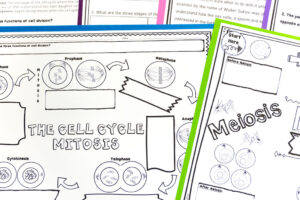You’ll likely start with the skeletal and muscular systems if you teach the human body systems. First, these two systems are well known to most students. Starting with the skeletal and muscular systems allows you to teach students how these body systems work with others to maintain homeostasis and keep us alive and healthy. Check out these ideas to learn how to teach the skeletal and muscular systems.
Teaching the musculoskeletal system
The skeletal system is made up of bones, cartilage, marrow, and joints that provide the framework for the human body. There are four jobs of the skeletal system:
- Protect internal organs
- Give shape and support to the rest of the body
- Provide movement
- Store materials until our bodies are ready to use them.
The muscular system helps our bodies move. This includes moving us from place to place and moving nutrients and other needs inside our body. There are three types of muscles:
- Cardiac: involuntary muscle found in the heart
- Smooth: involuntary muscle found in organs
- Skeletal: voluntary muscle found near bones
Ways to Teach the Skeletal and Muscular Body Systems
Using informational science texts will help you to boost literacy skills while teaching students
- functions
- parts
of the skeletal and muscular systems.
These texts can be used to anchor information that students can go back to when needed.
When using informational science texts, incorporate reading and writing skills such as
- underlining keywords
- highlighting important information
- circle vocabulary terms
- annotating in margins
- summarizing information in short sentences or paragraphs
Science texts are great because they can be used as
- an introduction to your unit
- homework assignment
- sub plans
- review of information.
Graphic organizers

Graphic organizers are useful tools for teaching the skeletal and muscular systems.
These worksheets will allow students to summarize and simplify information to have it all on one easy sheet.
Print or digital graphic organizers will allow you to assess if students can
- summarize information
- understand concepts
- refer back to texts
Furthermore, different graphic organizers can be used to summarize
- skeletal system
- muscular system
- how the systems work with other body systems
Videos
Students learn so much through videos so incorporate some of these into your classroom.
Hands on learning
Undoubtedly, our students learn best by using their hands, so reading about the parts of a bone is much different than seeing the parts.
Have students make a replica of a bone using easily found materials.
Students label each part and summarize what it does. Likely, students will better remember each part after they make it rather than just reading about it.
Review activities
Putting together materials as you learn how to teach the skeletal and muscular system can be difficult so grab these ready-made materials!
These materials will help students learn
- Parts of the skeletal system
- Parts of the muscular system
- Jobs of each body system
- How each system keeps the human body healthy











